Nokia Lumia 900 Review - Windows Phone with LTE
by Brian Klug on April 3, 2012 9:00 PM ESTCellular, WiFi, GPS, Speakerphone
The Lumia 900 uses Qualcomm’s MDM9200 baseband for cellular connectivity. It’s a 45nm LTE UE category 3 part we’ve seen numerous times before (the MDM9600 is functionally the same but includes CDMA2000 1x and EVDO 3GPP2 suite air interface support) but this is the first time we’ve seen it (and LTE) on a Windows Phone. I have to admit that at first I wondered what use cases on Windows Phone could really benefit from the inclusion of LTE, but having faster cellular connectivity does indeed make a perceptible difference. Interestingly enough Nokia does note the presence of Rx diversity for WCDMA on the Lumia 900 front and center, both under their “design” tab and under Data Network on the specifications page. It’s awesome to see another handset vendor realize that great cellular performance is noteworthy, even if Nokia has always been shipping handsets with either pentaband or great performance.
| Nokia Lumia 900 AT&T- Network Support | |||||
| GSM/EDGE Support | 850 / 900 / 1800 / 1900 MHz | ||||
| WCDMA Support | 850 / 900 / 1900 MHz (official, 2100 / AWS in FCC) | ||||
| LTE support | 700 MHz (Band 17), AWS (Band 4) - UE Category 3 | ||||
| Baseband Hardware | QCT MDM9200 | ||||
| HSPA Speeds | HSDPA 21.1 (Cat 14) / HSUPA 5.76 (Cat.6) | ||||
Since the Lumia 900 is headed to AT&T LTE, it includes LTE band 17 (700 MHz) and band 4 (AWS) support. For 3G WCDMA the Lumia 900 supports the usual suspects outlined in the table below, but also includes AWS approval in the FCC database. Were you to score an unlocked Lumia 900 there’s a chance it might just work on T-Mobile. Just like the Lumia 800 I suspect there are a few variants of the Lumia 900 with different WCDMA bands supported.
To test cellular performance I used BandWidth from the Marketplace which appears to use the speedtest.net servers. I tested AT&T LTE up in the Phoenix, AZ market which is currently 10 MHz FDD-LTE on band 17 for AT&T which corresponds to a maximum of 73 Mbps of downstream for a UE Category 3 device. BandWidth only offers a limited history buffer and no export functionality, but I saw speeds of up to 35 Mbps on the Lumia 900 and average speeds around 15–20 Mbps. Subjectively what I’ve seen on the Lumia 900 is very similar to the performance I’ve seen testing an AT&T Galaxy Note in the same market whose data I’ll share soon.
On 3G WCDMA, performance is definitely helped out by the presence of Rx diversity. I have seen 10–11 Mbps at my house with excellent proximity to an AT&T cell site. In other traditionally challenging places the Lumia 900 does a great job staying connected in my home market which lacks AT&T LTE.
The Lumia 900’s cellular settings page includes the ability to switch the device’s preferred air interface between EDGE/GPRS (E), 3G WCDMA (3G), and 4G LTE (4G). However the labeling here is actually hilarious - AT&T’s WCDMA “4G” marketing carries over to the Lumia 900, so selecting “3G” from the drop down will score you a “4G” indicator in the status bar. Likewise selecting “4G” from the drop down gets you “LTE” in the status bar. Finally, a concrete example of where AT&T’s re-branding marketing has resulted in an actual namespace collision!
I think it’s also worth noting that the Lumia 900 includes an excellent field test app with fields for every air interface which you can launch by dialing ##3282# just like on many other WP7 devices.

Antenna positions (from FCC Test Report)
Like many other phones, the transmit antenna is at the bottom of the device for GSM, WCDMA, and LTE. The WCDMA Rx diversity antenna and LTE MIMO antenna is located on the side with the volume and power/standby buttons. Remember that every LTE category 2 and above device needs two receive antennas for MIMO.
A number of users have asked me whether or not the Lumia 900 works with any old AT&T SIM, or if you absolutely need the SIM that comes with the device and LTE provisioning. I swapped my normal iPhone data plan provisioned SIM into the Lumia 900 and was able to get 3G WCDMA working fine. I didn't get a chance to test whether AT&T LTE works with that SIM, but I strongly suspect it doesn't. One small extra step is that you will need to use Nokia’s Network Setup application (available on the Marketplace) to change your settings from AT&T LTE to AT&T 3G APNs as shown above (ostensibly from pta to phone) so you can get data working, otherwise it won’t work.
WiFi
The Lumia 900 includes 802.11b/g/n WiFi - there’s only 2.4 GHz support just like every other WP7 phone, no 5 GHz yet to speak of. The device also connects at a single spatial stream 802.11n 72 Mbps short guard interval, 20 MHz channel rate. I’m fairly confident that the Lumia 900 is using Broadcom’s BCM4329 just like the Lumia 800, but I’m unable to verify to be completely sure. Either way I haven’t seen anything errant with WiFi on the Lumia 900 at all, range and performance is totally acceptable.
The Lumia 900 locates the WiFi, Bluetooth and GPS antenna in the same place, part of a module which appears to be part of the headset jack based on the FCC description.
GPS
Speaking of GPS, I had no issues at all with getting a good GPS fix on the Lumia 900 either while just playing with Bing maps, Nokia Maps, or while getting turn by turn directions from Nokia Drive. I strongly suspect that the Lumia 900 is using the GNSS functionality off of MDM9200, but it’s not clear whether GLONASS is supported or this is just GPS.
Speakerphone
The Lumia 900 speaker is at the very bottom of the device, just like the 800. Subjectively I have no issues with the 900's volume at all, either while on a speakerphone call or using it for navigation using Nokia Drive. In our controlled test with a sound data logger placed 3 inches away from the phone, the result the Lumia 900 is above average and definitely louder than the Lumia 800.
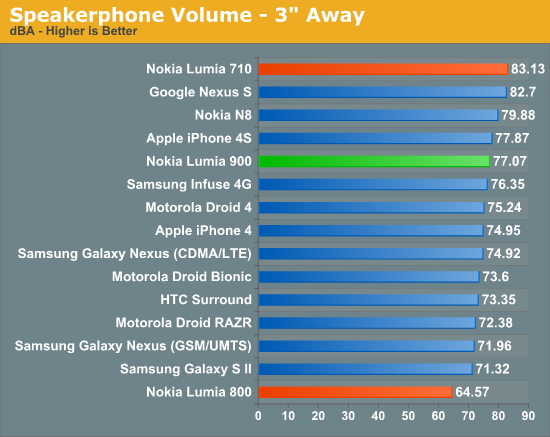
The next test is how well the Lumia 900's noise rejection works, which uses the second microphone at the very top in conjunction with the primary microphone in the speakerphone grille at bottom to do some common mode noise rejection. To test this I did what I always do and placed a call between the Lumia 900 and another AT&T phone (AMR-NB) and recorded the output of that call while increasing the volume of some music and decreasing it.
The results are excellent, as even at maximum volume I have a hard time discerning the background sound at all. I suspect that Nokia is using the Fluence noise rejection provided onboard the Qualcomm SoC, but I'm still not completely certain.


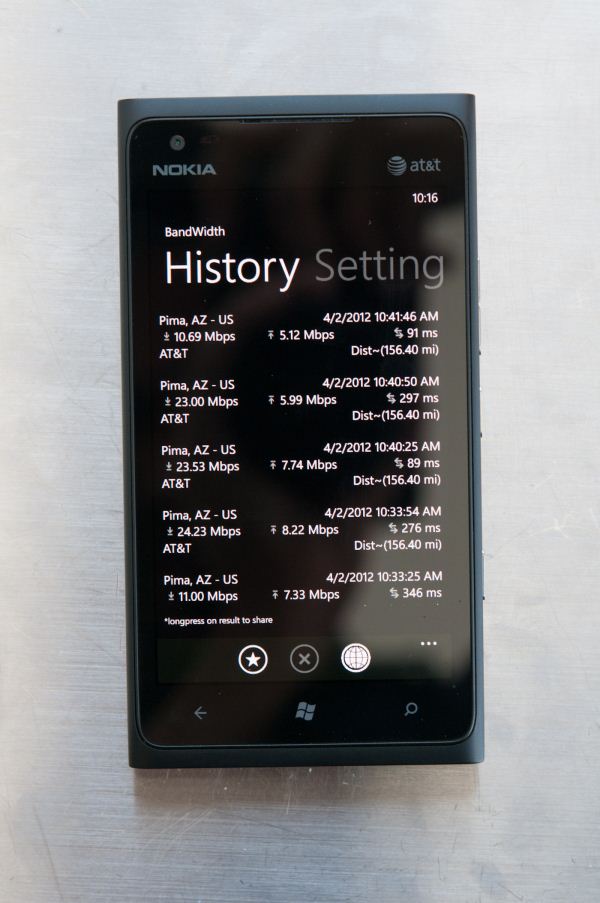
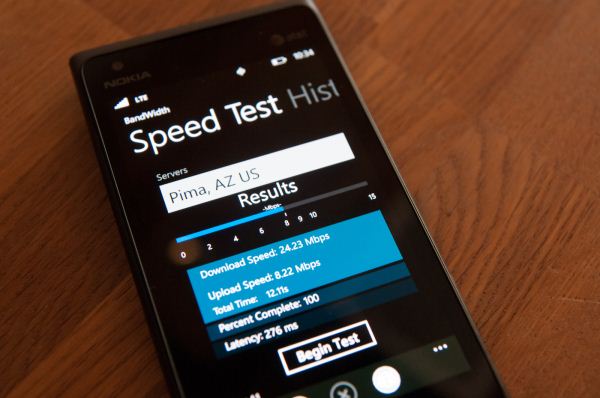
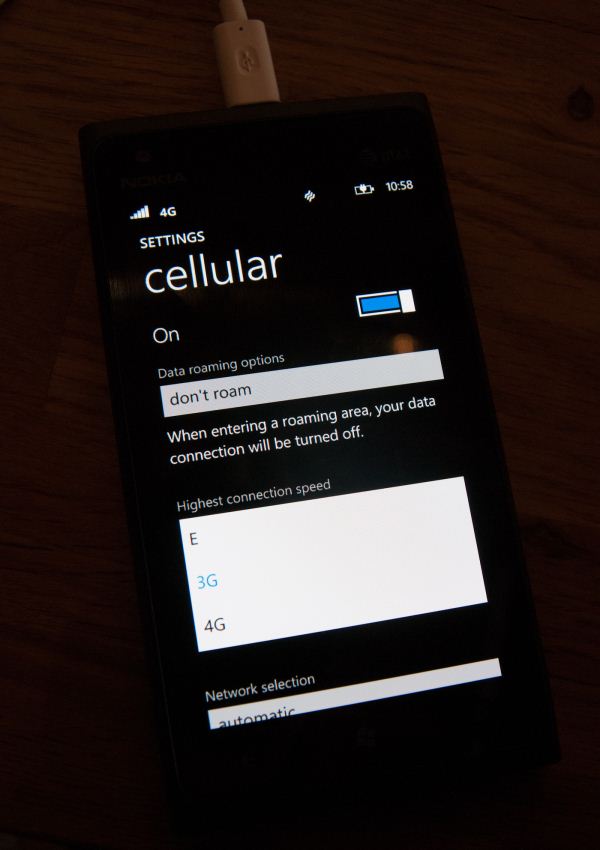
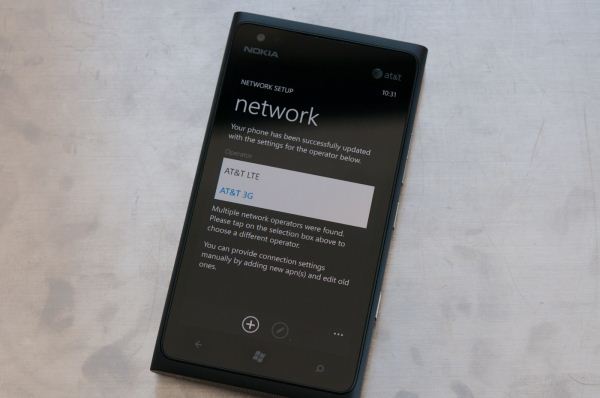








128 Comments
View All Comments
nitrousoxide - Tuesday, April 3, 2012 - link
"1.4GHz APQ8060"..apparently it's not dual-core.Brian Klug - Wednesday, April 4, 2012 - link
Oops, fixed! Thanks!-Brian
mister2d - Tuesday, April 3, 2012 - link
@Brian KlugYou mentioned tethering in the article. Can you talk more about whether you need a separate tethering plan for the Lumia 900 or can you just enable it out of the box without a fuss.
I asking since I am considering a jump from the original unlimited plan from AT&T/iPhone.
Thanks
Brian Klug - Wednesday, April 4, 2012 - link
Correct, just like other first-party AT&T phones it has a provisioning check to make sure you're paying a monthly rate for tethering.Otherwise it's functionally the same as every other phone I've tested with tethering - 5 clients maximum, WPA2, etc.
-Brian
jjj - Tuesday, April 3, 2012 - link
You are way too kind with this phone.The OS lacks so many features,the SoC is almost 2 gens behind,the recycled design is expired and fat(fat by even last year's standards) and the Windows brand can't ever be made apealing anymore.
Nokia can make nice hardware and ,i guess,we all want it to see it survive but they should have done better.
Aenean144 - Wednesday, April 4, 2012 - link
Concur.The only modern component in the thing is LTE, and that is arguably 1 year late. The SoC is 2010 era. The display is 2011 era, and I think I'm being generous. The OS software is still running a year's worth of development late compared to competitors. Microsoft has to wake up!
Even the chassis design isn't something stunningly new. It's nicely evolved from the design language introduced in the Nokia N8 almost 2 years. So we've seen this type of design for awhile. Nokia's messaging for this phone has been all wrong. They should have never let the media overhype this product.
MS has another card they can play: an Intel x86 Windows 8 smartphone. It's coming. A stylus and x86 compatibility will be features. ;)
sprockkets - Wednesday, April 4, 2012 - link
"I have to say that I’m impressed with how much Nokia Drive has improved since its initial launch on Windows Phone 7 with the Lumia 800. As of this writing the version is 2.0.0.2148, and it feels much more polished and responsive now since last I used it, and includes a few new features. The current version still requires you to preload maps for the regions you want over WiFi (so be sure you do this before getting in the car), but you basically get the ability to pre-cache whatever maps you want instead of hoping you have network connectivity where you’re going like with Google Navigation."You can pre cache maps as well with Google - just activate it in the labs dept, then download the area you need.
Also, stock browser on the HTC Sensation with the ICS update gets around 2000ms for sunspider. 6127ms is so outdated :)
Brian Klug - Wednesday, April 4, 2012 - link
Oh I know about that, but the radius ends up being too small for it to be practical or efficient. Eg if you're trying to cache a long roadtrip whose distance exceeds the radius, you'll need to precache multiple regions as opposed to just downloading all the maps.Also I need to update my SGS2 results with the ICS ROM. Unfortunately I had to send back the Sensation a while ago :/
-Brian
sprockkets - Wednesday, April 4, 2012 - link
Then again my HTC Sensation has maps from them (HTC Locations) and I can pre cache entire regions. Somehow it can also sync it up with Google's Navigation as well.tipoo - Wednesday, April 4, 2012 - link
Is it enough for a map of one city at least?